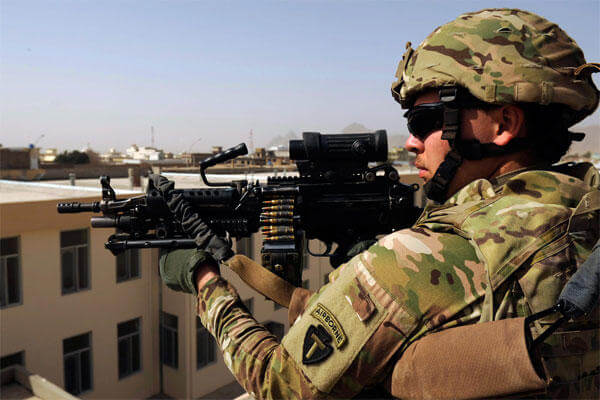All year long, Army leaders have dropped hints that the service will adopt MultiCam as its next camouflage pattern. The question now is will they finally announce the replacement of the Army's failed Universal Camouflage Pattern at the upcoming Association of the United States Army's annual meeting and exposition.
The annual event in Washington, D.C., has long served as the launching pad for big announcements affecting the entire force.
At the AUSA 2000, then Chief of Staff Gen. Eric Shinseki shocked the service by announcing that the black beret would be the official headgear for all soldiers. Prior to his decision, the coveted black beret was worn only by the members of the 75th Ranger Regiment. The decision sparked outrage and prompted the Rangers to adopt a tan beret.
At AUSA 2006, Army leaders gave soldiers the first look at the blue Army Service Uniform that would ultimately replace the Dress Greens.
The Army chose to unveil its new Army Combat Uniform, with its distinctive gray-green digital camouflage pattern on the service's birthday in June 2004.
Earlier this year, Army leaders considered unveiling the service's replacement for the ineffective UCP on the Army's birthday, according to Army sources. But the stiff cuts of sequestration and Congress's growing impatience with service-specific camouflage patterns prompted Army leaders to delay the long-awaited winner of the Phase IV Camouflage Improvement Plan.
While there has been no official announcement, leaders have hinted that the Army will adopt MultiCam, the pattern chosen in 2010 for use in Afghanistan, as the service-wide replacement for UCP.
In May, Chief of Staff Gen. Raymond Odierno told reporters that the service was about to adopt a new camouflage pattern. He didn't name MultiCam, but said it would be an “almost no-cost” solution – referring to the pattern already in production and in use by soldiers in Afghanistan.
Sgt. Major of the Army went even further in September, telling soldiers during a speech that the service would soon adopt a camouflage pattern similar to the one worn by soldiers in Afghanistan.
Made by Crye Precision LLC of Brooklyn, N.Y., MultiCam is the pattern that outperformed the service's Universal Camouflage Pattern, or UCP, to become the Army's pattern for soldiers deploying to Afghanistan. UCP was nonetheless adopted in 2004, but came under congressional scrutiny when soldiers complained about its poor performance in Afghanistan.
Army uniform experts and scientists have been evaluating a handful of patterns that emerged from the service's exhaustive Phase IV camouflage improvement effort.
Earlier this year, UCP came under fire again in a story by The Daily, an online news site, which quoted several Army scientists from Natick Soldier Systems Center, Mass., alleging that the Army selected UCP long before testing was complete.
It was the first time Natick officials have publically pointed the finger at PEO Soldier and Army leaders, charging that UCP cost taxpayers billions in uniforms and matching body armor, backpacks and other equipment.
But criticism of the UCP is nothing new. In fact, two Natick studies – one completed in 2009 and the other in 2006, showed that MultiCam outperformed UCP in multiple environments.
Then in June 2009, Pennsylvania's Democratic Rep. John Murtha, who was then chairman of the House Appropriations Subcommittee on Defense, got involved in camouflage issue. Murtha pushed the service to look for a better camouflage pattern after receiving complaints from sergeants about the UCP's poor performance in the war zone.
Murtha died in 2010, but his directive prompted the Army to launch a multi-phase camouflage effort. Many patterns were evaluated in Afghanistan, but MultiCam was the clear winner for the country's multi-terrain environment.
Earlier this year, the Army awarded contracts to four vendors to make camouflage-patterned material for uniforms and equipment as a result of Phase IV of the service's camouflage improvement effort.
In addition to Crye Precision, ADS, Inc., teamed with Hyperstealth, Inc., of Virginia Beach, Va.; Brookwood Companies, Inc of New York; and Kryptek, Inc. of Fairbanks, Alaska were chosen.
In March, the Army decided to drop the fifth finalist -- which was a government pattern developed at Natick. The pattern was too similar to one of the industry submissions, which scored higher in the initial evaluation, uniform officials said.
Natick officials would not release details of its pattern, but experts say it was likely from the Scorpion effort, a pattern developed by Crye Precision that was very similar to MultiCam. So far, Crye officials have refused to reveal details about the pattern selected for Army evaluation.
Each finalist submitted a family of camouflage patterns for desert, woodland, and transitional along with a single coordinated pattern for individual equipment such as body armor and load-bearing gear so soldiers wouldn't have to change their kit from one environment to the next.




























